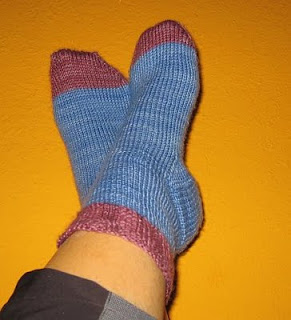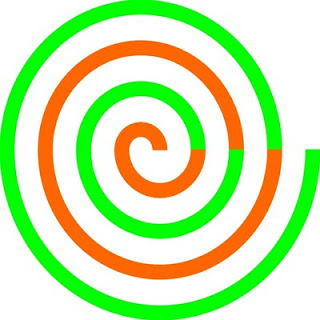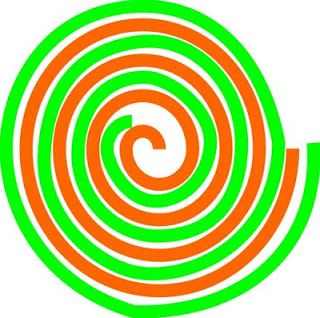The holidays were a welcome opportunity to get some more knitting done, and not only are the blue let's-try-doubleknitting-socks off the needles (and on my feet today), there is something new on the needles.
But from the beginning.
After getting started on the blue socks, I figured out several things about this double knitting thing. Most important was the fact that if you have both threads running over one index finger and knit, it's always the thread near the stitch worked. For the left sock, it's the thread running on the left side of the needle, and for the right sock, it's the thread on the right. For purl stitches, I take the finger to one side of the needle, and provided that I didn't let the threads on the finger cross each other, it is still the thread nearest the stitch worked. This makes purling and thus ribbing (and all the other fun things) very feasible. With a bit of practice, of course.
I also learned that splitting yarn makes things harder.
And that starting a free-style rib pattern at two places at once was too much for me.
That cabling needs more pre-planning than "I'll just try it", because it will draw in the fabric considerably.
That dark-blue wool with simple to no pattern (I think ribbing does not count as a pattern!) makes for a long, boring knit.
That casting off at the cuff might have gone better with a little more preparation (read: with knowing more about casting off very, very loosely or even better, learning the surprisingly stretchy bind-off).
And it took me most of the way up the ribbed (and very short) leg to figure out that marking one sock and its corresponding working thread with a little bit of contrasting thread would make things much, much easier - because detecting a yarn swap after half a round is much less work in undoing than detecting the yarn swap when it becomes obvious by connecting two socks four or five (or more) rows down.
So now I have deliciously soft, worked toe-up ankle socks in dark blue with a little bit of ribbing in the leg. The outside (knit on the inside) is a bit fuzzy, and at some places I have mangled the yarn a little, but they fit my feet, they are warm, and they have been a real learning experience. And I got the bind-off loose enough that the cuff just goes over my heel and high instep.
After this, I had to start on some new socks. To be completely honest, one of the reasons the blue socks are ankle socks is that I really, really wanted to start those new socks with that wildly variegated yarn we had bought for my stash in London.
And there were several free days spent with friends where chatting (or listening) and knitting went gloriously well together. So this is how the new socks look today:
Again, I have learned several things already on these socks, for example: Cuff-down is a really nice way to work, and I might prefer it to toe-up. It's especially easier to try on cuff-down socks than toe-up socks with this method.
I have large calves (I knew that already) and that means that if I skip swatching, cast on, then realise that the circumference is too large for foot and ankle by about six stitches, I can still go on knitting and just decrease on my way down the leg.
Ribbing is actually nice to work in this method, at least 3x3 ribbing is.
Variegated yarns make double-knitting much, much easier (because chances are good that yarn A and yarn B have slightly different or really different colours at the same time).
It's still necessary (or at least a seriously good idea) to mark one sock and the corresponding working thread with a marker loop. (You can see some pink marker thread on one of the yarn tails and on one of the working yarns on the photo.)
Little knotted loops of cotton or other smooth threads make wonderful stitch markers that get into the way of the needles very little to not at all.
I am easily amused, because watching the yarn change colours is fascinating enough for me to not mind long stretches of the same pattern (or non-pattern), at least not too much.
At least simple lace is very much possible in that method (and loads of fun, too), even if I still need some more practice with handling k2togs - yarn-overs are actually very pleasant to work for two socks at once, and if the stitches are not too tight, I can do a ssk without rearranging the stitches from a-b-a-b to a-a-b-b.
This is fun, and I see more socks in the future. Maybe even lace socks. And cabled socks. And whatever else strikes me as totally unavoidable to knit...
Pattern is Kai-Mei from Cookie A's book "Sock Innovation", yarn is a Supersock yarn from Cherry Tree Hill Yarns in colourway Martha's Vineyard.
I'm sorry if you are a non-knitter and/or not interested in all these knitting posts. But the bug has bit me, I fear...
But from the beginning.
After getting started on the blue socks, I figured out several things about this double knitting thing. Most important was the fact that if you have both threads running over one index finger and knit, it's always the thread near the stitch worked. For the left sock, it's the thread running on the left side of the needle, and for the right sock, it's the thread on the right. For purl stitches, I take the finger to one side of the needle, and provided that I didn't let the threads on the finger cross each other, it is still the thread nearest the stitch worked. This makes purling and thus ribbing (and all the other fun things) very feasible. With a bit of practice, of course.
I also learned that splitting yarn makes things harder.
And that starting a free-style rib pattern at two places at once was too much for me.
That cabling needs more pre-planning than "I'll just try it", because it will draw in the fabric considerably.
That dark-blue wool with simple to no pattern (I think ribbing does not count as a pattern!) makes for a long, boring knit.
That casting off at the cuff might have gone better with a little more preparation (read: with knowing more about casting off very, very loosely or even better, learning the surprisingly stretchy bind-off).
And it took me most of the way up the ribbed (and very short) leg to figure out that marking one sock and its corresponding working thread with a little bit of contrasting thread would make things much, much easier - because detecting a yarn swap after half a round is much less work in undoing than detecting the yarn swap when it becomes obvious by connecting two socks four or five (or more) rows down.
So now I have deliciously soft, worked toe-up ankle socks in dark blue with a little bit of ribbing in the leg. The outside (knit on the inside) is a bit fuzzy, and at some places I have mangled the yarn a little, but they fit my feet, they are warm, and they have been a real learning experience. And I got the bind-off loose enough that the cuff just goes over my heel and high instep.
After this, I had to start on some new socks. To be completely honest, one of the reasons the blue socks are ankle socks is that I really, really wanted to start those new socks with that wildly variegated yarn we had bought for my stash in London.
And there were several free days spent with friends where chatting (or listening) and knitting went gloriously well together. So this is how the new socks look today:
Again, I have learned several things already on these socks, for example: Cuff-down is a really nice way to work, and I might prefer it to toe-up. It's especially easier to try on cuff-down socks than toe-up socks with this method.
I have large calves (I knew that already) and that means that if I skip swatching, cast on, then realise that the circumference is too large for foot and ankle by about six stitches, I can still go on knitting and just decrease on my way down the leg.
Ribbing is actually nice to work in this method, at least 3x3 ribbing is.
Variegated yarns make double-knitting much, much easier (because chances are good that yarn A and yarn B have slightly different or really different colours at the same time).
It's still necessary (or at least a seriously good idea) to mark one sock and the corresponding working thread with a marker loop. (You can see some pink marker thread on one of the yarn tails and on one of the working yarns on the photo.)
Little knotted loops of cotton or other smooth threads make wonderful stitch markers that get into the way of the needles very little to not at all.
I am easily amused, because watching the yarn change colours is fascinating enough for me to not mind long stretches of the same pattern (or non-pattern), at least not too much.
At least simple lace is very much possible in that method (and loads of fun, too), even if I still need some more practice with handling k2togs - yarn-overs are actually very pleasant to work for two socks at once, and if the stitches are not too tight, I can do a ssk without rearranging the stitches from a-b-a-b to a-a-b-b.
This is fun, and I see more socks in the future. Maybe even lace socks. And cabled socks. And whatever else strikes me as totally unavoidable to knit...
Pattern is Kai-Mei from Cookie A's book "Sock Innovation", yarn is a Supersock yarn from Cherry Tree Hill Yarns in colourway Martha's Vineyard.
I'm sorry if you are a non-knitter and/or not interested in all these knitting posts. But the bug has bit me, I fear...










